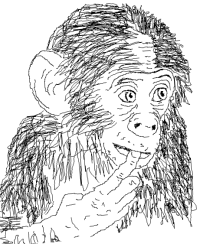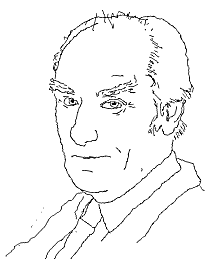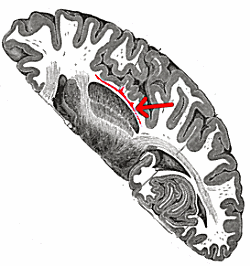
 At the Francis Crick Memorial Conference back in July the participants signed a Declaration (pdf) affirming that animals are conscious. The key passage reads:
At the Francis Crick Memorial Conference back in July the participants signed a Declaration (pdf) affirming that animals are conscious. The key passage reads:
“The absence of a neocortex does not appear to preclude an organism from experiencing affective states. Convergent evidence indicates that non-human animals have the neuroanatomical, neurochemical, and neurophysiological substrates of conscious states along with the capacity to exhibit intentional behaviors. Consequently, the weight of evidence indicates that humans are not unique in possessing the neurological substrates that generate consciousness. Nonhuman animals, including all mammals and birds, and many other creatures, including octopuses, also possess these neurological substrates.”
Actually, you’ll notice that that paragraph crams on the brakes an inch short of saying that animals are conscious. It says they have various substrates and that it doesn’t seem to be impossible that they should have ‘affective states’. More boldly it says they have the capacity to exhibit intentional behaviours.
We could certainly do with some clarity on this issue – but why are scientists issuing a Declaration? Don’t they just publish papers and leave the results to speak for themselves? There’s a clear intention that the Declaration should have political impact, at least encouraging protection of animals, perhaps lending support to the idea of animal rights, possibly even giving a boost to veganism if we assume Philip Low (Portuguese text) was serious. (In fact I suppose we might have to go further and intervene to prevent carnivores of other species pursuing their traditional diet.)
Whatever we feel about that, it takes us into contentious territory, and I think there are in any case two other factors which make discussion in this area especially complicated. One is that there is a hidden dispute here about standards of proof. At least three standards are, as it were, in play. There’s the ordinary/political standard of proof, which requires something to be shown to be true clearly enough that we believe it and generally expect others to believe it. There’s the scientific standard of proof, which requires more rigorous evidence, reproducibility of results, and endorsement by peer review. Then there’s the philosophical standard of proof, which requires that no rational being who understands the case could possibly think otherwise, which actually makes it tough to prove that animals even exist, never mind what their mental states are. All of these different standards have their place, but discussion of animal consciousness is handicapped by differences and misunderstandings about which to invoke in which contexts.
Animal consciousness is also a peculiarly emotive subject. Our conclusions may be very strongly affected by feelings of empathy, and indeed there is an argument that empathy is an appropriate response. Although I’ve never heard this particular argument made explicitly, it can be argued legitimately that even if animals are not conscious, we are better people if we let our empathy cause us to believe they are, because empathy is such a vital human quality it even trumps strict truth in this case. It’s better to waste some sympathy on creatures that don’t really deserve it than risk remaining cold to those that do, in other words. At any rate some may feel that those who deny that animals have feelings at all (step forward, Descartes) are deficient in perception or even perhaps in moral sense, a feeling that sceptics on their side are not apt to welcome.
So discussion is potentially difficult, and so it is with all due caution I say I think the Declaration is probably a bad idea overall; and that there are three particular problems with it.
The first problem is that it doesn’t seem well-motivated scientifically, by which I mean it doesn’t seem to be inspired by any definite scientific result. The preliminary passages of the Declaration do allude to various pieces of research, but the basic case is that animals have much of the same brain hardware as human beings, and also exhibit the right sorts of behaviour. We’ve known that for a long time. If some scientific Rubicon has been crossed recently, I missed it and I can’t see it set out here. To make matters worse the Declaration seems to come close to a clunking logical error, along the lines of: other areas than the neocortex are involved in having feelings; animals have those other areas, therefore animals have feelings. That wouldn’t work: you could as well argue that: other organs than the eye are involved in seeing; people whose eyes have been gouged out have those other organs; therefore people whose eyes have been gouged out can see. You can’t really dismiss the neocortex that easily.
The second problem is that we’re not told clearly which animals are conscious, and no allowance is made for different levels of consciousness in different species. On the face of it it seems the claim is that insects are just as conscious as anyone else (so those classic observations of stereotyped behaviour in sphex wasps must somehow have been wrong). In fact Christof Koch seems to be saying everything is conscious. That’s too extreme to be plausible and too vague to be helpful, especially in a context where we’re implicitly thinking about political rights and moral status. This is by no means an academic problem in a world where, for one thing, experimental animals may be sacrificed to help save human lives; if we think all beings have an equal share of consciousness there will certainly be no more animal experiments, and if we get it wrong either way that has serious consequences.
The third problem is that we’re not told what kind of consciousness. The Declaration seems mainly to be about whether animals feel pain, but it makes no distinction between a capacity for suffering and a capacity for rational planning (or indeed self-awareness). These are radically different things, and we might well find it much more likely that animals have the former than the latter.
This is important in two respects. First, if animals have feelings, then we might want to enact laws protecting them from pain; but we won’t feel inclined to give them rights unless we think they have the kind of intentional thought that would allow them to exercise those rights. To have legal rights you need to be the kind of entity that might go to court to enforce them, and presumably the kind of entity which also has duties and gets punished for infractions. Actually, that’s not quite true; we might still want to give animals the special kind of rights that children or comatose patients have, which need to be exercised on their behalf by others and entail no obligations; but even if we do that it’s important to keep track of what legal/moral status we’re actually awarding.
Second, the presence or absence of rational conscious thought might affect our view of how important feelings are. It might be that some animals can indeed feel pain in a basic way, but that without human-style neocortex-driven awareness their pains are only like dream ones, or like pains we instantly forget (some people take the view that a forgotten agony doesn’t matter; and indeed surgeons use mnestics, which make you forget the pain, almost interchangeably with true anaesthetics, which actually stop you feeling it in the first place). Even if animals feel pain it might still be that their pains are of lesser value or even of no account at all; and the presence or absence of explicitly entertained thoughts, projects and desires might be relevant.
There’s an awful lot more to be said about these issues, quite a lot of it on the Declaration’s side, but that brings me to the overall problem. What is the Declaration for, and what will it be used for? I presume the aspiration is that it will be cited wherever the treatment of animals is an issue. Its function is surely meant to be to give clarity, but to do it by curtailing argument; to end discussion. That’s certainly liable to be the way it is used, at any rate. I don’t like that at all; there are cases where it’s legitimate to try to close down an area of discussion, but I don’t think this is one; the attempt is at best radically premature, at worst profoundly unhelpful. If anything we should be promoting discussion. Wouldn’t it have been better, and more appropriate to Crick’s memory, if the participants in the Conference had, in that spirit, published a list of good questions?
 Doctors at George Washington found by chance recently that stimulating a patient’s claustrum served to disrupt consciousness temporarily (abstract). The patient was being treated for epilepsy, and during this kind of surgery it is normal to use an electrode to stimulate areas of the brain in the target area before surgery to determine their role and help ensure the least possible damage is done to important functions. The claustrum is a sheet-like structure which seems to be well connected to many parts of the brain; Crick and Koch suggested it might be ‘the conductor of the orchestra’ of consciousness.
Doctors at George Washington found by chance recently that stimulating a patient’s claustrum served to disrupt consciousness temporarily (abstract). The patient was being treated for epilepsy, and during this kind of surgery it is normal to use an electrode to stimulate areas of the brain in the target area before surgery to determine their role and help ensure the least possible damage is done to important functions. The claustrum is a sheet-like structure which seems to be well connected to many parts of the brain; Crick and Koch suggested it might be ‘the conductor of the orchestra’ of consciousness.


